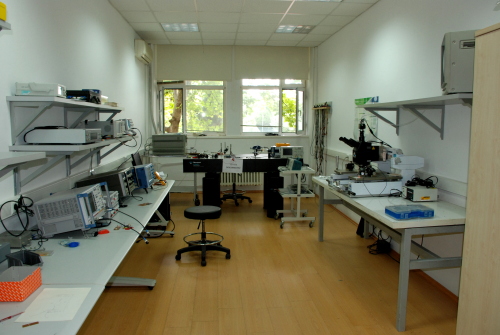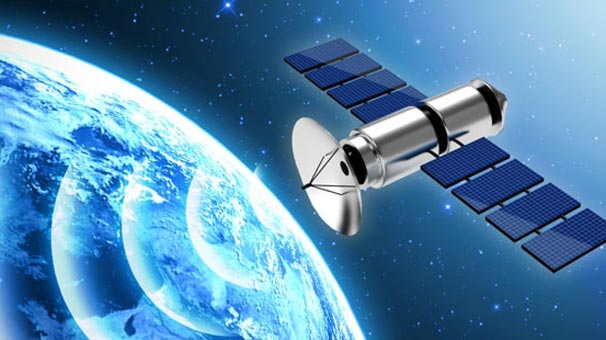The Bogazici Photonics and Optical Wireless Communication Laboratory (POWCOL) was established in 2006 by Dr. Heba Yüksel as she joined the department from Ciena Corporation. At POWCOL, multidisciplinary research projects in the fields of optoelectronics & photonics as well as optical communication are conducted. The main research focus at POWCOL is atmospheric turbulence, transmitter/receiver design, aperture averaging, and image sensing for Free-Space Optical Communication links (FSO), security and design issues in optical fiber communication systems, Visible Light Communication (VLC), 3D surface topography using optical systems, optical sensors, and antennas. You can find more current information regarding POWCOL lab on https://powcol.boun.edu.tr/.
Research Laboratories in BUEE

Microwave Radar and Communications Laboratory focuses on radar systems on various platforms, transceiver structures and radar imaging algorithms. The laboratory’s scope of study includes both in-door studies such as fast radar prototyping using software-defined radios, generating radar images and s-parameter measurements as well as out-door studies to implement radar systems on various mobile platforms and monitoring different environments. Radar systems encourages multi-disciplinary work which include controlling radar platforms, designing suitable antennas, RF-frontends and high-speed electronics for different needs and developing radar signal processing algorithms. The laboratory has several high frequency RF signal generators, 26.5GHz Spectrum Analyzer, 40GHz Vector Network Analyzer and sampling oscilloscopes to support design and research process.

Antennas and Propagation Research Laboratory (BOUNtenna) concentrates on the design of reconfigurable antenna elements and arrays for mobile devices of limited size. The focus areas of application include wearable and implantable smart devices within the Body Area Networks (BANs), Internet of Health Things (IoHT), Internet of Things (IoT), MIMO communications. Capabilities in the laboratory include but are not limited to electromagnetic field simulation, antenna/PCB prototyping, mechanical modeling, physical body phantom development (head, knee, hip, etc.), S-parameter measurements. In addition, BOUNtenna has a Faraday Cage with 80 dB shielding between 1-18 GHz.

Micro Nano Characterization Laboratory (MNL) deals with the design, modeling and experimental characterization of nanomechanical systems (NEMS), microelectromechanical (MEMS), micro-optomechanical systems (MOEMS), medical micro devices as well as analog and radio frequency (RF) microelectonic circuitries. Design capabilities of the laboratory include Finite-element based physical modeling, equivalent system modeling, integrated-circuit design and lumped element mechanical modeling. Experimental characterization efforts at MNL focus on the vibration-amplitude measurement, dynamic characterization of micro-systems, high-frequency distributed parameter modeling, fiber-optic transmission systems.

BUMEMS is a fabrication laboratory for quick prototyping used to do research on micro-electro-mechanical systems (MEMS), polymer thin film microfabrication, polymer electronics, polymer light emitting diodes (LED), microfluidics, integrated wireless sensors and actuators and electrochemical etching and deposition for nano/micro patterning.

VAVlab (Volumetric Analysis and Visualization Group) is a multidisciplinary group conducting research primarily on image/signal processing and analysis. Application fields range from multimedia and industrial applications to medicine, including diagnostics and decision support systems, medical image processing and analysis, simulations, brain network analysis, biosensor signal analysis as well as industrial IoT applications. VAVlab maintains a wide network of collaborations with national and international academia.

Bogazici University Signal and Image Processing (BUSIM) laboratory has been one of the most productive multidisciplinary research milieus. Its research horizon encompasses the theory and the applications of image processing, speech processing, video coding, computer vision, signal processing for communications; security and biometry. Since its inception in 1993 it has graduated more than twenty PhDs and close to a hundred MSc students. BUSIM has hosted several guest researchers and a multitude of national and international projects.

The speech group at Boğaziçi University was initiated in year 1998 as Dr. Arslan joined the department from Entropic Research (later acquired by Microsoft). In year 2005, Dr. Murat Saraclar joined the group from AT&T Labs Research. Currently there are 6 PhD and 2 MSc students actively working on speech processing research. Main topics include large vocabulary continuous speech recognition, voice conversion, 3-D audio-visual synthesis, speech synthesis, speech therapy and speaker identification. Until now 2 PhD dissertations and 17 MSc theses have been completed by the group members. The courses related to speech research at the department are as follows:
Speech Processing, Psychoacoustics, Automatic Speech Recognition, Advanced Speech Processing, Statistical Natural Language Processing.
The group is involved in two European Union Network of Excellence projects, namely SIMILAR and BIOSECURE. Aside from the cooperation with the partners of those projects, there is active collaboration with Boğaziçi University Linguistics Department, Istanbul Cerrahi Hospital, and Anadolu University Speech Therapy Center. The spin-offspeech research company from the group, SESTEK (www.sestek.com.tr), has products based on speech recognition, speech synthesis and voice conversion technology.

Bogazici University Wireless Communications Laboratory (WCL) was established in 2005 with the grants received from the Bogazici University Reseearch Projects Fund and the Scientific and Technical Research Council of Turkey (TUBITAK). These two, as well as the State Planning Organization (DPT), are still the main funding agencies of WCL. Currently, WCL has three full-time faculty members, three PhD and three MS students conducting research on high-speed wireless/mobile/satellite communications. WCL also has close collaborations and joint projects with the VLSI Design Lab (BETA), the Computer Nertwork Research Lab (NETLAB) and the Satellite Communications Research Lab (SATLAB). You can find information on the WCL personnel, main research areas and activities, research projects and publications at wcl.boun.edu.tr.

NECS (Networked & Embedded Control Systems) Laboratory conducts interdisciplinary research primarily on mathematical system theory, networked control systems, wireless resource allocation and automotive control. Some of the application areas include robotics, communication networks, sensor/actuator networks and automotive. Within the laboratory, a testbed is also setup to develop a team of robot players eligible to compete for the championship in the RoboCup Small-Size League.
